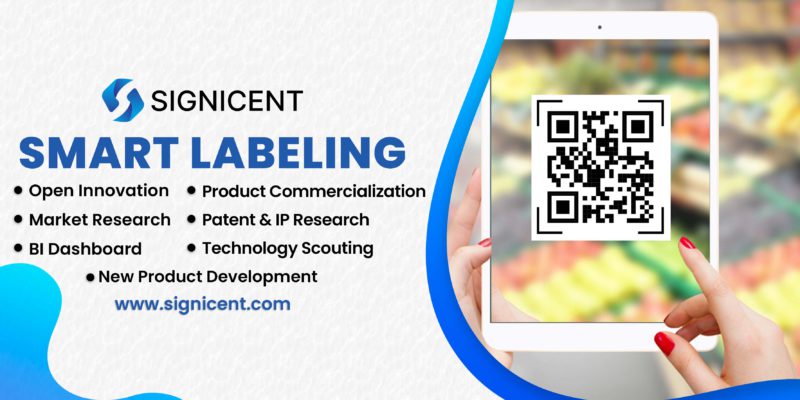The objective of the smart labelling report is to conduct a technology intelligence study on smart labelling. All different aspects that would be covered during the study are technology summarization, key innovations, technology categorization & innovation trends.
Smart Tags
Smart tags are tags that use technology in a non-traditional manner. The smart tags can be categorized majorly into EAS (Electronic Article Surveillance), RFID, QR code, NFC tags, sensing labels, ESL (Electronic Shelf Labels), and dynamic display labels. The application sectors include retail inventory, perishable goods, pallets, electronic & IT asset, reusable goods and security access. Due to the undying competition faced by packaging companies, more and more companies are exploring innovations in smart packaging and incorporating smart tags and labels.
3D Printed Smart Labels
In this section of the smart labelling report, the 3D printed smart labels are discussed. Due to the constantly growing consumer applications preference for technologically advanced solutions, the demand for the smart labelling market is likely to grow in near future. A very interesting concept of injecting fruit with shellfish-based growth regulators to keep it fresh is in practice.
The South China University of Technology and the University of Warwick have developed novel fruit labels that are capable of keeping fresh produce edible for longer. They use coaxial 3D printing, the team’s tags feature cellulose nanofibers loaded with shellfish extracts and growth regulators. These can be pre-programmed to release steadily into the pores of fresh foods.
Challenge faced is that 1-MCP is too volatile for mixing. Therefore, Synthetic plant growth regulator ‘1-MCP’ is paired with organic dyes like the shellfish-extract chitosan. It delays production from ripening. The team decided to 3D print a ‘core-shell structure,’ capable of releasing chitosan in a controlled way and preventing foods from spoiling early.
The sodium alginate (SA) and κ-carrageenan (KC) matrix materials are integrated into the bio-ink, as well as a pH-sensitive blueberry anthocyanin, due to its distinctive colour, that could later be used to monitor freshness. This formula was then loaded into a Y&D 7300N coaxial 3D printer and deposited into layers, before being spray-cured and freeze-dried to form hollow fibres. These nanotubes would be able to balance the electrostatic effect of chitosan against the device’s CNF shell, allowing them to ‘trap’ 1-MCP and release it on demand.
Each year Signicent provides consultancy to hundreds of organizations to help transform their innovations to value.
Flexible Strain and Temperature Sensing Tag
In this section of the smart labelling report, a flexible Strain and Temperature Sensing NFC Tag has been discussed. In most food packages, the presence of undesired gases could indicate the loss of quality and shelf-life of the food. As these originate from the oxidation of the content or microbial growth. To address this need, a smart sensing tag is incorporated that detects strain and temperature to monitor packaged food quality.
The tag comprises flexible sensors (either a microchannel-based flexible strain sensor or a printed temperature sensor) and a light-emitting diode (LED) indicator to detect dynamic strain or temperature in a semi-quantitative and visual way.
The temperature sensor showed a 70% change in resistance for a temperature change of ~60°C. The presented wireless-enabled passive system can be used as a smart label for food packaging applications.
Smart Label with Color Indicator
The smart label helps to identify the quality of the packed pasteurized milk. This smart label has anthocyanin extract purple sweet potato on the bottle packaging of pasteurized milk.
Earlier chemical dyes were used to detect the changes in pH, but the use of chemical dyes has the possibility of a toxic effect if accidentally swallowed or in contact with the product. So it does not guarantee product safety.
A solution to overcome this problem is to use natural dyes that are sensitive to changes in pH, namely anthocyanins. A smart label prototype made of purple sweet potato anthocyanin extract. Study the level of freshness and the feasibility of smart labels as an indicator of the level of milk freshness at room temperature and cold storage.
The freshness of milk is categorized into fresh (purple smart label colour), fairly fresh (faded purple smart label colour), and not fresh (reddish-purple smart label color). The results of the feasibility of smart labels on pH stability indicate color changes in both acidic and alkaline conditions, but more stability is evident in acidic conditions. These are helpful in identifying fresh and good-quality milk.


